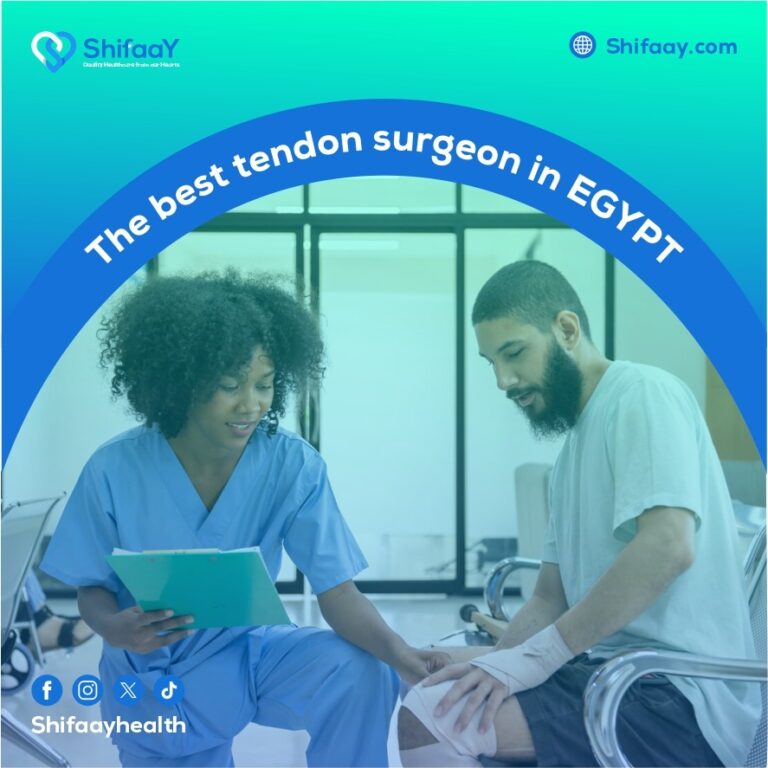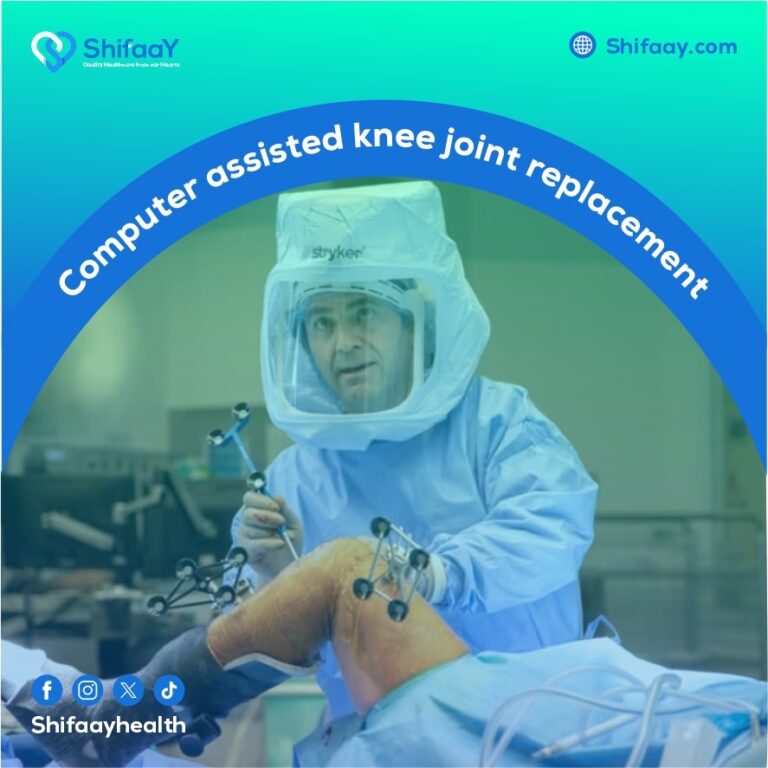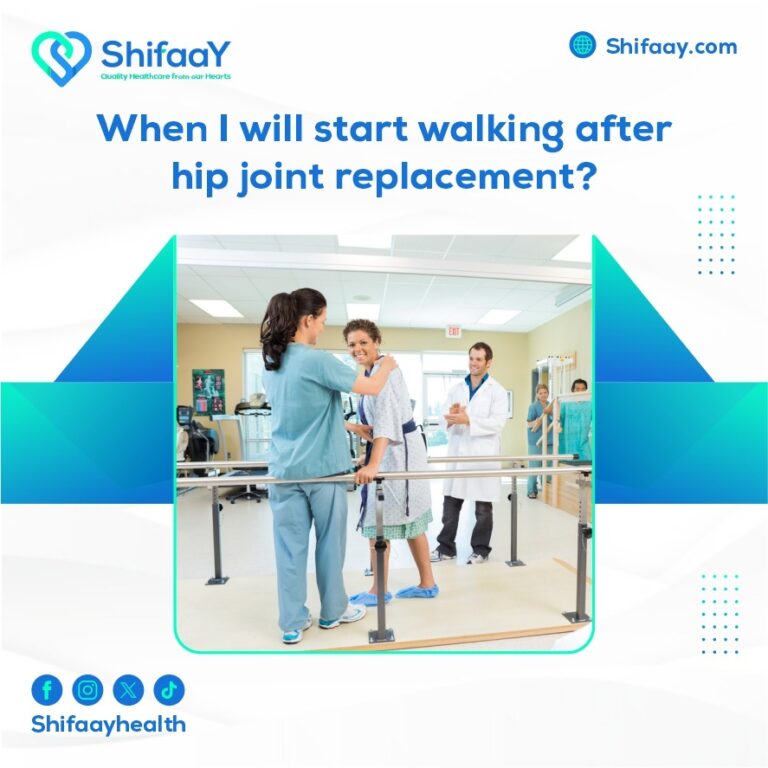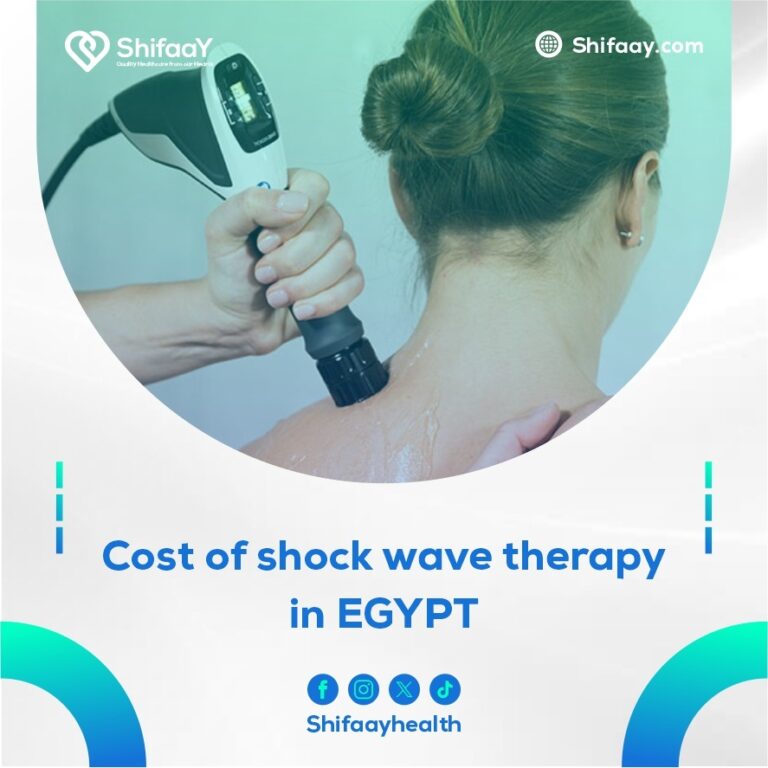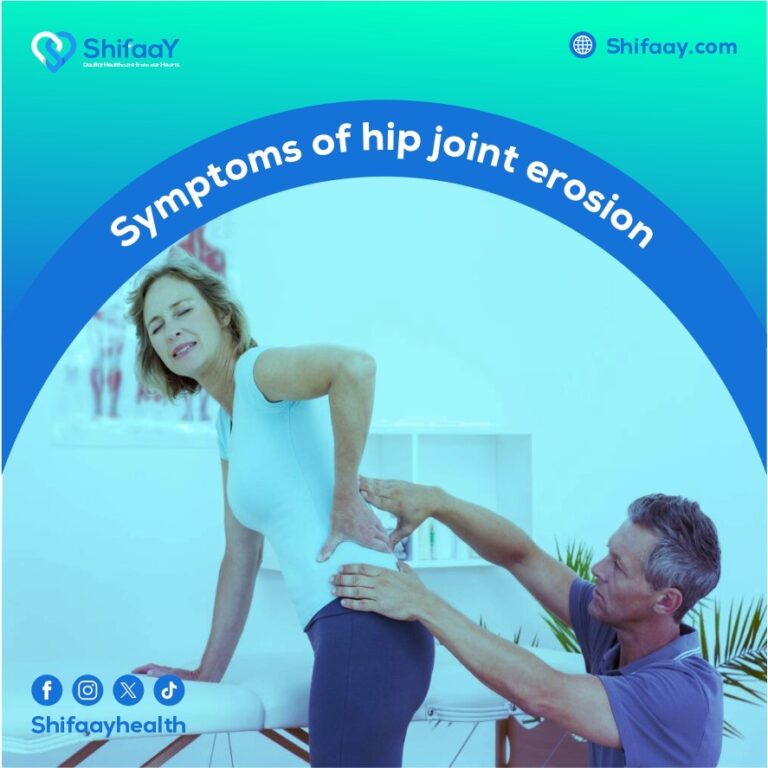Treating tennis elbow pain
Tennis elbow treatment, also called lateral epicondylitis, is a very painful and stressful condition of the elbow that can be brought on by overusing the arm muscle. This can cause a lot of inflammation, which increases the risk of cuts and ruptures in the tendons that run along the outer side of the elbow, connecting the muscle to the bone. This injury may be more common in people between the ages of 30 and 50 who use their palm joint frequently. Furthermore, it might be more common in athletes, particularly tennis players, because of the continuous strain that these sports place on their elbow joint muscles, which in turn causes weakness, damage, tearing, and significant stress on the tendons that surround those muscles. In addition, a tennis player’s elbow is a serious condition characterized by excruciating inflammation. It is also sometimes linked to a less common condition that is a tiny tear in the tendons that connect the muscles of the forearm outside of the elbow.
If you notice any symptoms that indicate tennis elbow injury, also known as “arthritis of the elbow,” you need to call Shifaay Center, the best medical tourism center in Egypt immediately because it is one of the greatest and most significant specialized medical facilities that can provide you with the highest quality medical care. Shifaay provides you with top-notch medical care because the knowledgeable doctor who works at this center diligently records any previous illnesses you may have had, along with any symptoms you may have experienced as a result of them. Furthermore, he will conduct a thorough medical examination to ensure that the tennis elbow injury is accurately diagnosed.
The chief physician of the center will only order X-rays and other effective imaging tests if additional testing is suspected for this condition, as an ECG may reveal issues related to nerve or muscle dysfunction or the nerve’s ability to send signals to the muscles, which may be related to tennis elbow. What is the treatment for a tennis player’s elbow? And what are the causes that led to this? What symptoms might indicate an injury with it? Is it possible to fully recover from tennis elbow through physical therapy exercises alone? We will answer all of these questions in detail in the following paragraphs of this article.
Treatment of tennis elbow
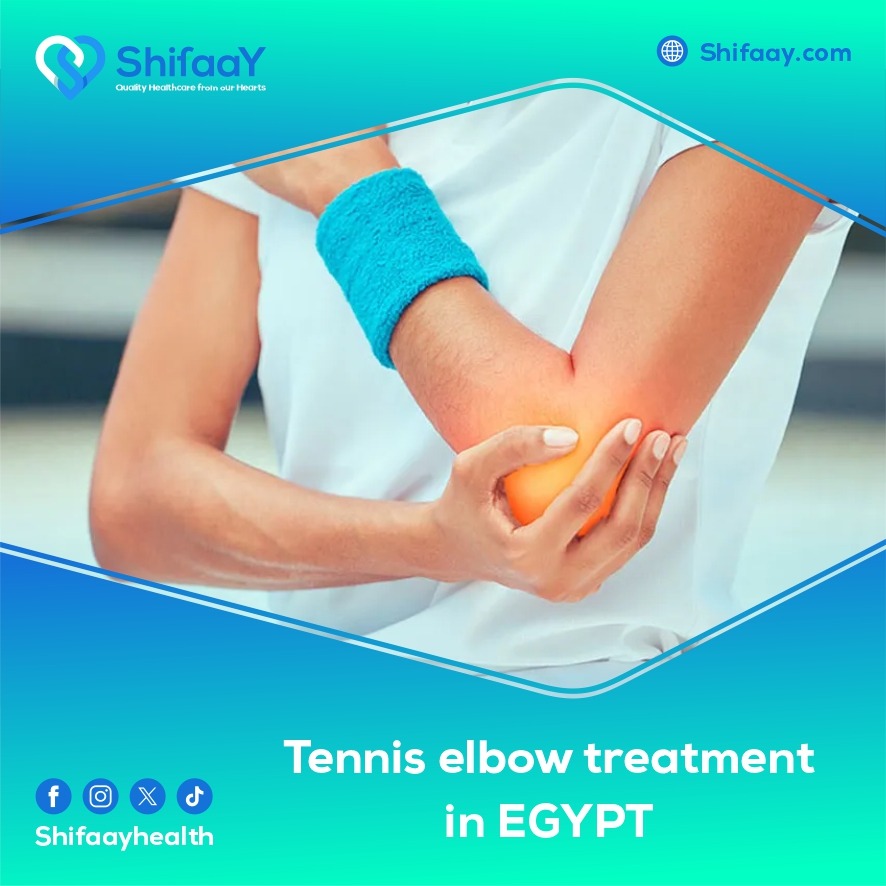
Naturally, if you hear someone discussing treating tennis elbow, you might assume that they are a tennis player. However, tennis elbow is actually just a common, painful condition that affects people of all ages and genders, and it can lead to issues with the tendons and muscles that surround the elbow. Tennis elbow disease may be named after tennis players, who are most susceptible to this injury and may be famous for having it. In many medical cases, this condition might be treated with taking anti-inflammatory and painkilling medications along with getting enough sleep. Treatment for tennis elbow may also include the following:
It is first recommended to use effective therapeutic techniques, such as rest and painkillers, to protect the elbow. And so, the elbow of a tennis player might naturally get better.
A specialist doctor affiliated with Shifaay Center, the best medical tourism center in Egypt will then evaluate the condition’s primary cause. If the condition is the result of an injury related to exercise, the doctor may evaluate your technique and suggest adjustments to reduce the strain on the injured tissues. In addition, physical therapy sessions can help in stretching and strengthening the muscles and tendons. Because of this, you should learn all the appropriate stretches for tennis elbow. You should also limit the amount of pressure at the injury site to using an elbow arthritis brace or a forearm belt.
Following that, some non-surgical treatments like dry needling or ultrasound therapy might be advised. If these solutions do not work, surgery is the last option to remove all damaged tissue and relieve pain.
Also follow: The cost of shoulder tendon rupture surgery in Egypt
Symptoms of tennis elbow
It is reasonable to assume that everyone is aware that tennis elbow is one of the injuries caused by overuse of the elbow, given that playing tennis is one of the main activities that can contribute to the phenomenon known as “tennis players’ elbow.” However, a number of other common causes may also contribute to this phenomenon, which could make you feel extremely painful. One of the most significant symptoms of tennis elbow is listed below, and it is as follows:
● Lost the ability to grasp things.
● The pain worsens over time.
● Weakness of the arm.
● Experiencing severe pain while performing certain activities, such as shaking hands and turning the door handle.
● Pain in the outer part of the elbow, which can spread to the arm and palm joint.
Treatment of Tennis elbow injury
Tennis elbow injury is a painful condition that usually affects the elbow joint.
Tennis elbow is a medical condition that can affect people of any age or activity level. It is believed to be caused by inflammation or strain in the tendons surrounding the elbow, which can result in health problems in the muscles and tendons around the elbow bone. Because table tennis, badminton, and ground tennis require frequent elbow movement, tennis elbow can also spread to other sports. Furthermore, a variety of preventative measures, such as getting enough rest and using painkillers and anti-inflammatory drugs, can be used to treat tennis elbow.
It should be noted that there are certain crucial steps that Shifaay Center’s physical therapy physician must follow when treating bowel disease, and that all patients suffering from this condition must be cautious to follow them. These steps are illustrated as follows:
- First, your physical therapist will ask you to get enough rest.
- The doctor will then advise you to apply ice to the affected area for 20 minutes every day for several days.
- The doctor will then prescribe a series of exercises to help you treat the condition, which you will be expected to do at home on a regular basis.
- After that, the doctor will prescribe a number of pills and creams that will definitely accelerate the healing process. Local injections are usually a possibility because the quicker the therapeutic intervention, the better the therapeutic outcomes and the shorter the healing period. However, in the event that none of these approaches work, surgery will be the most suitable and effective course of action for treating tennis bowel syndrome.
Treatment of Tennis elbow inflammation
Tennis elbow is a condition caused by overuse of the tendons and muscles in the elbow, also known as lateral epicondylitis. This condition is usually associated with repetitive movements of the arm and wrist. Despite the name of the condition, most people with tennis elbow do not play the game because some people are able to engage in repetitive motion-intensive activities that can lead to the development of tennis elbow. There are no known causes for this condition, but examples of these people include those who work in the plumbing, painting, carpentry, and butchering industries.
Tennis player’s elbow pain mostly affects the area where the strong, rope-like tendons from the forearm muscles attach to a bony protuberance on the outside of the elbow, though it can also radiate to the wrist and forearm. While physical therapy, medication, and rest are often effective in treating tennis elbow pain, they may not be sufficient for individuals whose symptoms interfere with their daily activities, as these individuals may need to undergo medical procedures such as surgery or injections.
Treatment for tennis elbow with medication
Tennis elbow symptoms can undoubtedly go away on their own with a little complete rest, the appropriate attention, and the choice of an effective therapeutic approach that fits the activities of the condition and expedites recovery. However, the healing journey may take a lot of time. Treatment options for tennis elbow fall into two categories: conservative measures and surgery (which is reserved for extreme cases when conservative measures fail). Recovery from tennis elbow can take up to 18 months.
Furthermore, tennis elbow may be treated conservatively with a range of conventional treatment options, the most important of which are still physical therapy and non-surgical, minimally invasive techniques that have been demonstrated to speed up the recovery process for patients with tennis elbow. Using a medical combine is probably the most efficient way to obtain this. Methods of treating tennis elbow may include the following:
● Rest: To give the tendons enough time to heal, a patient with tennis elbow should avoid strenuous activities and rest their elbow for a few weeks. They should also maintain their elbow’s basic range of motion.
● Taking medication: Painkillers like paracetamol are included in the list of topical non-steroidal anti-inflammatory medications (NSAIDs), which are applied directly above the elbow and are considered the best ointments for inflammation because they help to reduce pain and inflammation of the tendon associated with tennis elbow.
Plasma treatment for tennis elbow
Tennis elbow is a common, excruciating elbow injury caused by overuse or repeated use of the arm and wrist in repetitive activities like tennis and other sports. In the medical community, it is also known as lateral epicondylitis. Most important factors that could influence how tennis elbow is treated are the patient’s age, the medications he takes, the intensity of his pain, and his medical background. The goal of this treatment is to reduce the pain and inflammation in the joint, and it is one of the most effective therapeutic approaches. One factor that may help achieve the best outcome is Shifaay Center’s method which is plasma treatment for tennis elbow, as recent research has demonstrated the critical and significant role platelet-rich plasma plays in fortifying and encouraging muscles and tendons to quickly heal and recover.
This plasma can be extracted from a patient’s blood under ultrasound guidance and injected into the injured or inflamed elbow regions. Once the plasma is injected, the patient with tennis elbow may release potent bioactive proteins that speed up the healing process. As a result, stem cells may be recruited. It may take several sessions to fully induce mild inflammation and initiate the body’s natural healing response, which will allow the patient to heal and feel significantly better.
Treatment of tennis elbow with cortisone
The common elbow condition known as tennis elbow, or lateral epicondylitis, is caused by overuse of the hand, forearm, and arm muscles. It can also be brought on by weak back swings from tennis or other activities, as well as from repeated arm and wrist motions. Therefore, people with tennis elbows do not always play tennis. This disorder attaches to the lateral epicondyle through muscles and tendons, and it can occur inside or outside the elbow. Handling this condition can make even the most basic functional tasks extremely painful and difficult, such as shaking hands, pressing a door handle, or opening a jar.
Many people with tennis elbow may seek treatment of tennis elbow with cortisone from Shifaay Center, the best medical tourism center in Egypt because it is one of the most successful centers specializing in treating all bone diseases, including this disease, and because cortisone injections are one of the most efficient therapeutic approaches that help with pain, inflammation, and many other joint injuries. Usually, ultrasonic waves are used to guide this in order to see the exact location of the injury and to prevent damage to the tissues and nerves.
people most susceptible to tennis elbow
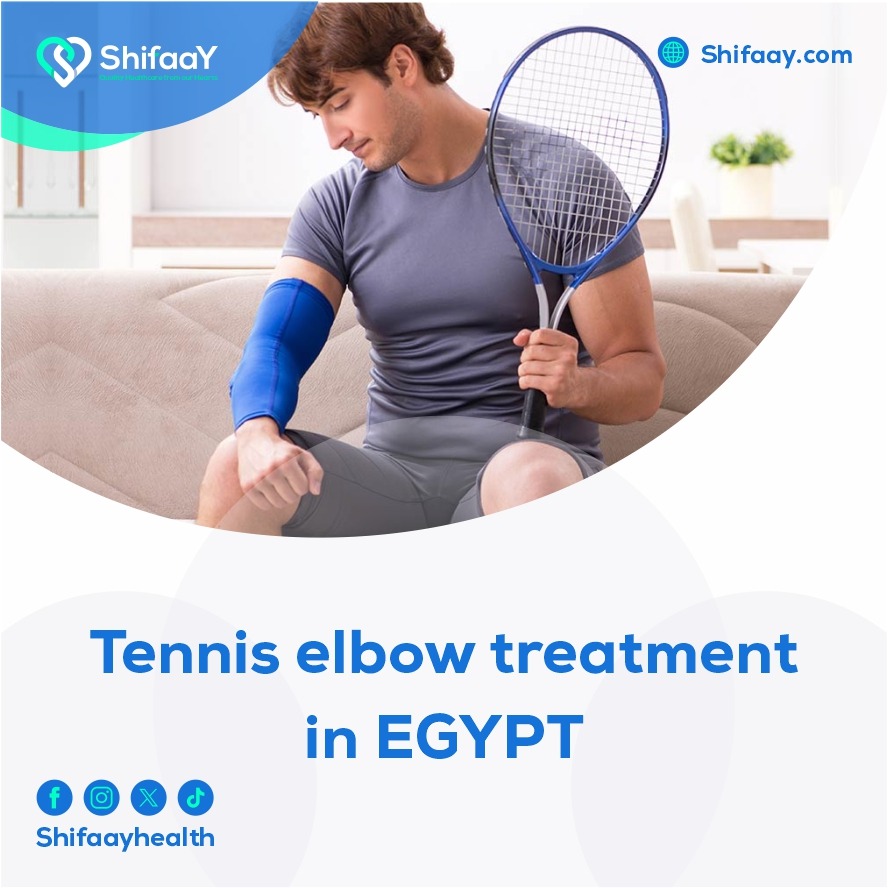
Tennis elbow and other repetitive arm injuries can occur in athletes who play tennis or any other sport requiring constant arm motions. The disease known as lateral epicondylitis may be caused by inflammation of the tendons that connect the muscles on the outside of the upper arm to the elbow bones. This condition manifests as pain, tenderness, weakness in the arms, difficulty gripping objects, and other symptoms. Treatment options for tennis elbow include rest, ice, compression lifting, and physical therapy, which aims to strengthen and stretch the surrounding muscles. It is possible that in severe medical situations, surgery will be required to replace the injured tendon.
It is crucial to keep in mind that tennis elbow can occur to a lot of people who perform jobs like carpentry, painting, plumbing, and butchering that put more strain on one arm than the other. Still, it is possible that it will usually develop in the opposite arm. According to reports, up to 50% of professional tennis players and 1% to 3% of the general public suffer from tennis elbow. Tennis elbow affects people of all ages, but it is more common in those between the ages of 30 and 50. It should be noted that men may experience tennis elbow more frequently than women.
Tennis elbow can also affect athletes, people with repetitive arm motion disorders, people who play tennis frequently, and people in occupations that require repetitive arm motion. These individuals include, among others, butchers, carpenters, mechanics, plumbers, painters, and baseball players.
Also follow: Rotator cuff surgery in Egypt
How is tennis elbow diagnosed?
Tennis elbow is not diagnosed by tests or examinations alone; instead, a clinical examination and the patient’s description of their pain are the main methods of diagnosis, though X-rays are occasionally used as well.
How can a tennis elbow injury heal quickly?
Tennis elbow can be healed quickly and painlessly if you follow a few key guidelines, like resting the elbow and arm, avoiding carrying objects that are far from the body as they may cause strain on the arm’s muscles and tendons, and limiting painful activities (both sporting and non-sporting).
How long does tennis elbow take to heal?
In most cases, recovering from tennis elbow can take anywhere from six months to two full years. Some patients with this disease recover 90% of their function in a year or less. During this time, resting the affected arm completely and avoiding daily activities that could aggravate it further are important precautions to take.

